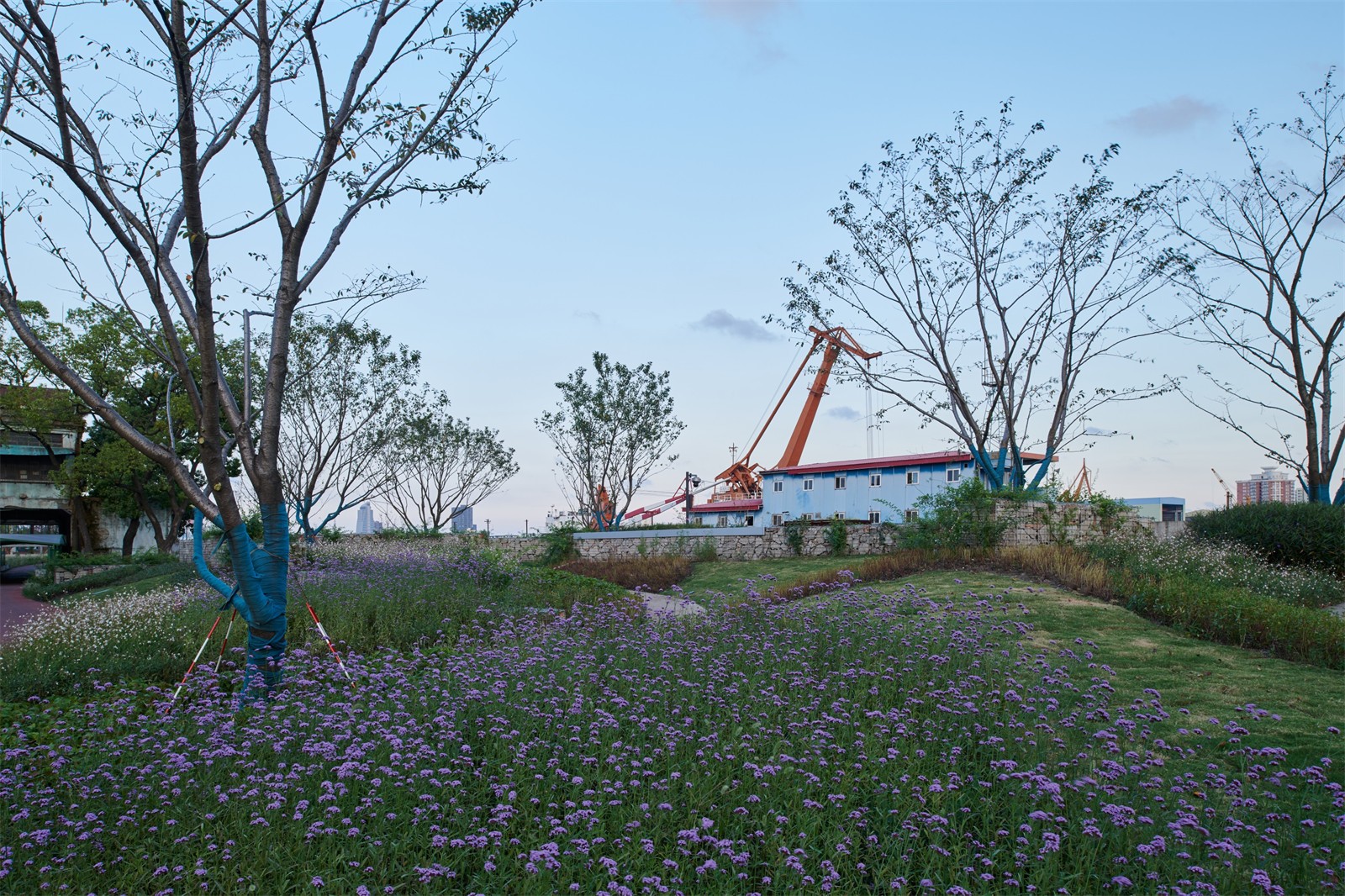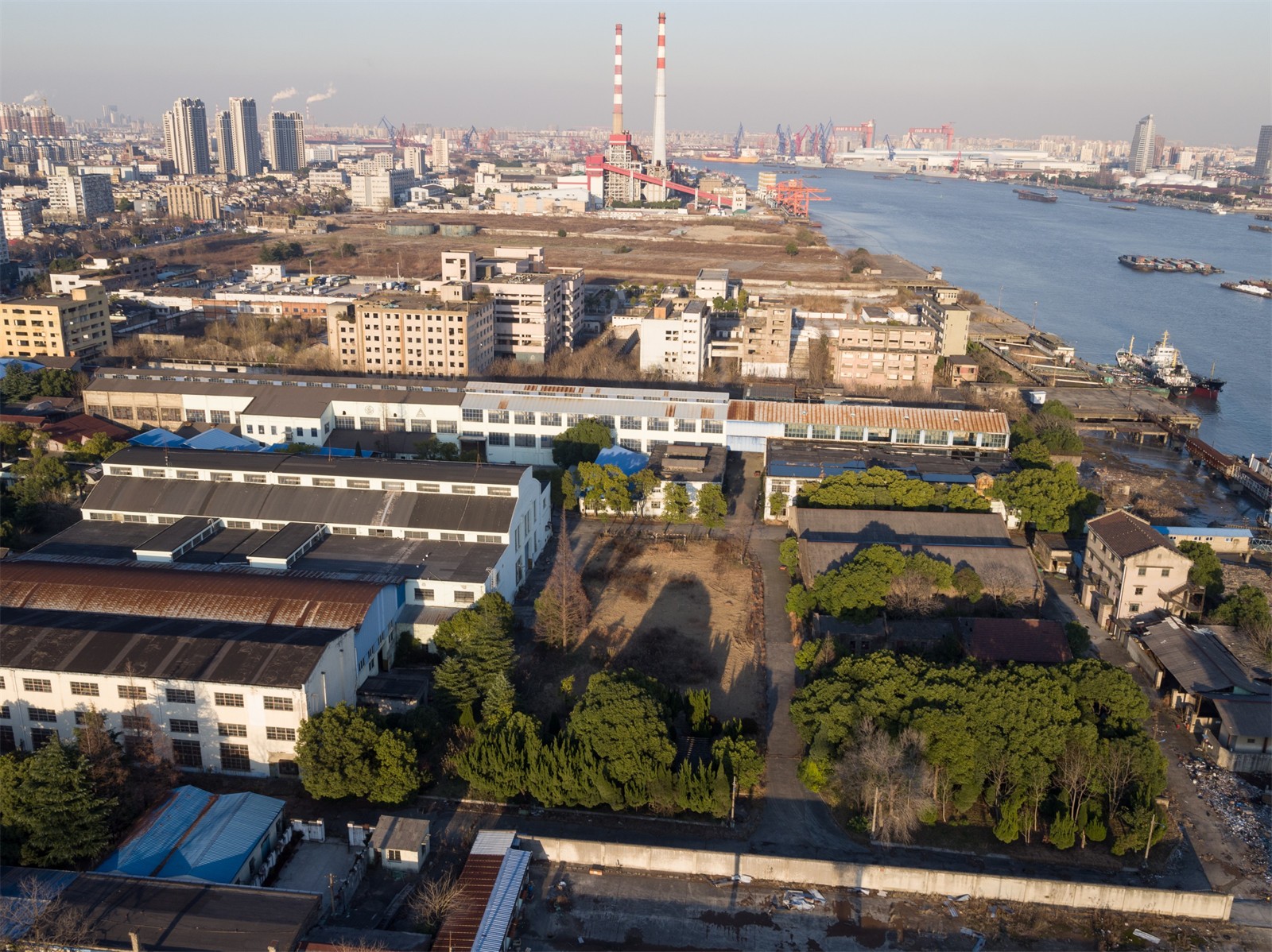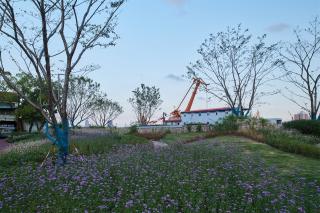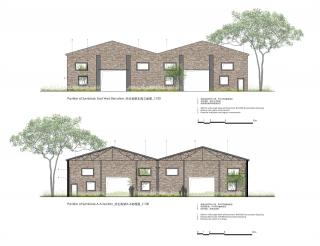杨树浦六厂滨江公共空间更新 | 刘宇扬建筑事务所
▼二期工程完工后的项目夜景鸟瞰 © 田方方
The night bird’s eye view of the project after construction of phase 2 © Tian Fangfang

总体规划与定位
Overall Planning and Orientation
项目总体区位在上海杨浦大桥以东,隶属于杨浦滨江南段,这一片原先为“杨树浦工业带”——杨树浦路以南、滨临黄浦江,西起秦皇岛路,东至黎平路的条带状工业聚集区域。自西向东横跨六个历史厂区,分别为电站辅机厂西厂、国棉九厂、电站辅机厂东厂、上海制皂厂、杨树浦煤场及杨树浦煤气厂,面积约15万平方米,拥有约1.2公里的水岸线。作为上海近代工业的发源地滨江工业带,绵延十数里的工厂区具有时间早、类型多、分布广、规模大等特点。公共空间以密集的工业厂区(300-500m一段)为设计节点,体现了对空间多样性的需求。
The overall location of the project is at east of Shanghai Yangpu bridge, which belongs to the south part of Yangpu Riverfront. This area was originally called "Yangshupu Industrial Belt"——an industrial agglomeration area south of Yangshupu Road, adjacent to Huangpu River, starting from Qinhuangdao Road in the west and ending at Liping Road in the east. From west to east, it spans six historic factories, namely, Power Station Auxiliary West Building, National Cotton No. 9 Factory, Power Station Auxiliary East Building, Shanghai Soap Factory, Yangshupu Coal yard and Gasworks. It covers an area of about 150,000 square meters and has about 1.2 kilometers of waterfront. As the birthplace of modern industry in Shanghai, the industrial zone along the riverside stretches for tens of miles and has the characteristics of early time, multiple types, wide distribution and large scale. The public space takes the dense industrial factory area (300-500m section) as the design node, reflecting the demand for spatial diversity.
▼项目主体——改造后的共生构架 © 田方方
The main body of the project:transformed open pavilion of symbiosis © Tian Fangfang


继完成浦东民生码头贯通项目之后,致正建筑工作室、刘宇扬建筑事务所和大舍建筑设计事务所,三家独立事务所于2018年起受邀参与杨浦滨江南段公共空间的前期策划与概念规划,并以集群模式组织联合工作组由致正建筑工作室牵头完成全过程贯通设计和分段区域的深化设计。最终希望实现有限介入,低冲击开拓。以最小限度的人工介入,最大限度地保留工业码头的原真性。除了参与牵头总体规划和贯通设计,刘宇扬建筑事务所也具体承担了其中电站辅机厂东厂区域的深化设计及后期现场配合与落地。
Following the completion of the Pudong Minsheng Wharf Reconnection project, three independent firms, Atelier Z+, Atelier Liu Yuyang Architects and Atelier Deshaus, has been invited to participate in the preliminary planning and concept of the Yangpu riverfront public space since 2018. Further more, a joint working group was organized in a cluster mode, which was led by Atelier Z+ to complete the whole process design and section area deep design. Ultimately, it hopes to achieve limited intervention and low impact development. With minimum manual intervention, the authenticity of industrial docks is retained to the maximum extent.In addition the overall planning and connection design, Atelier Liu Yuyang Architects also take in charge of the deep design and construction coordination of the area of Yangpu riverfront Power Station Auxiliary East Building.
▼共生构架与雨水花园夜景 © 田方方
The night view of open pavilion of symbiosis and the rain garden © Tian Fangfang

电站辅机厂东厂
Power Station Auxiliary East Building
场地为上海电站辅机厂东厂原址。历史时期由铜梁路为界,1949年前, 分别属于一战时期建立的三井木工厂及1921年间建立的慎昌洋行工厂。其中,慎昌洋行工厂专业制造机器,在三十年代,曾先后参与上海等地包含龙华机场,外滩中国银行等重要工程。
It is the former site of Shanghai Power Station Auxiliary Equipment Works East Building.
1952年,两厂与慎昌洋行在杨树浦路西侧另一厂区合并为浦江机器厂,本区域称之为东厂;并于1953年成立上海锅炉厂。1980年电站辅机厂由锅炉厂分出独立经营,分为东西两厂,成为国内规格最大, 品种最多的电站辅机制造专业企业,以及我国核电设备制造的骨干企业。2004年,东厂内原慎昌洋行地块,作为上海滨江创意产业园试行,运行期间对上海及亚洲地区老厂房保护及功能再造多有启发。
▼场地原貌 © 陈颢
The original state of the site © Chen Hao
设计策略与景观布局
Design strategy and landscape layout
方案基于保野趣,保生鲜,保慢活,保自然的总体规划愿景,透过低扰动介入的方式,保留现场香樟林,并改造原有一座仓库成为开放式的共生构架。设计重点挖掘场地历史肌理,因地制宜地引入慢行系统,以历史遗迹如内河,建物遗址为印记,重塑景观结构,打造印记花园、野趣区、生态水池等景点。使场地不但是承载城市生活的滨江开放空间,也具备江南园林移步换景的悠游趣味性。
The design aims to preserve the wildness, freshness, nature and downshifting character of the site by adopting the concept of limited disturbance. The existing camphor trees are retained and one of the former warehouses is transformed into an open Pavilion of Symbiosis. The design also takes into consideration the historical texture of the site and introduces a system of pedestrian routes and bicycle paths. The newly built elements, Garden of Vestige, Meadow in Succession and Eco Pond, are established through historic relics, the canal and building remains, and as the skeleton to the landscape. As an ensemble, the site provides visitors different touches of landscape when strolling inside, and together they make the East Campus an everyday landscape which not only functions as the riverside open space for city life, but also offers fun and diversity similar to traditional gardens in the Yangtze River Delta.
▼现场保留的原樟树林 © 陈颢
The existing camphor trees © Chen Hao

▼打开之后的共生构架 © 田方方
The open state of the pavilion of symbiosis © Tian Fangfang

共生构架
Open Pavilion of Symbiosis
共生构架原为锅炉厂(1953-1979)期间建成的老厂房,因安浦路通过而需要被拆除; 设计利用道路斜切角度,对原结构采取一半拆除、一半保留的加固策略,所形成的特殊形态和几何关系,结合新旧门窗洞口,打开屋顶,引入阳光和绿化, 加入亲子沙坑、景观造坡,使墙里墙外形成一体。既保留了老锅炉厂的空间样貌, 又转化成了供市民休憩活动的开放场所,成为建筑与景观、历史与城市的共生构架。
An old factory building of Shanghai Boiler Works (1953-1979) was set for demolition due to road planning. By analyzing the angle and orientation of the planned traffic road, the design proposed to retain and reinforce half of the original building to form a unique structure and geometric condition. The roof was opened up to let in sunshine and to allow the growth of new green vegetation from within. Preserved as well as newly installed doors and windows, sandpit for kids, and the landscape coteau make the whole structure an integrated whole. By preserving and restoring the original space and partial structure of the Boiler Works, the Pavilion of Symbiosis functions as an open space for all citizens, fusing together architecture and landscape, history and city.
▼共生构架轴测分析图
Concept AXO diagram of the open pavilion of symbiosis

▼一半拆除一半保留加固的共生构架 © 陈颢
Half dismantled,half retained and reinforced pavilion of symbiosis © Chen Hao


▼共生构架与跑步道 © 田方方
The open pavilion of symbiosis and running path © Tian Fangfang

▼规划道路穿过共生构架 © 田方方
The planning path comes across the open pavilion of symbiosis. © Tian Fangfang

▼加固后的建筑墙体和内外融合的景观空间 © 田方方
The reinforced building walls and the integrated landscape space © Tian Fangfang

印记花园
Garden of Vestige
在原厂房的轮廓上, 以原建筑破碎后再利用的材料砌牆, 再现了原场地的遗迹; 并透过景观堆坡与园路的引入, 将室内的办公空间转化成了花园的日常, 与漫步道一同, 联繫了工业厂区与黄浦江河岸景观。
The demolished fragments of the original building are reused to build a wall representing the remains of the former sites. A landscape slope and garden paths lead to the Garden of Vestige and the indoor office space is transformed into a garden space. The garden, linked up with the riverside paths, offers both views of Huangpu Riverside and Yangpu industrial zone.
▼游园般的景观步径 © 田方方
The picturesque walking path © Tian Fangfang


野趣区
Meadow in Succession
在原内河及厂房遗址上, 以混凝土砌块牆的手法重现原厂房空间, 并透过人工化草甸概念, 鼓励参与与观察, 在草甸变迁与演化的过程中,体会上海的四季。
Walls made of concrete blocks contained within the gabion baskets are built on the former site of canal and factory buildings to represent the original factory building relics. The man-made meadow also encourages visitors to observe the growth and decay of vegetation and to experience the four seasons of Shanghai.
▼雅致的向野草甸 © 陈颢
Elegant wild meadow © Chen Hao


▼野趣区游步径施工过程与效果 © 陈颢
The construction process and effect of the trials © Chen Hao


▼野趣区施工过程与效果 © 陈颢、田方方
The construction process and effect of the wild area © Chen Hao,Tian Fangfang


▼融入自然的石笼挡土墙 © 田方方
The gabion baskets functioning as retaining walls integrates with the nature well. © Tian Fangfang

▼石笼挡土墙效果 © 陈颢
The construction effect of the gabion baskets © Chen Hao
生态水池
Eco Pond
生态水池利用海绵城市技术, 聚集了场地裡的雨水到原厂房/內河的遗址上并与地下水位相连接。它是人与黄浦江自然的联系, 也是亲子亲水之所。
Applying the techniques of sponge city, the Eco Pond collects rainwater of the site and is connected with the ground water, the Eco Pond brings out natural accesses to Huangpu River for visitors to enjoy. It brought out a natural access between visitors and the Huangpu River, while providing the ground for leisure activities.
▼生态水池的施工过程与效果 © 陈颢
The construction process and effect of the eco pond © Chen Hao


▼概念方案设计图
Concept design

▼景观轴测分析图
Concept AXO diagram of the landscape

▼场地立剖图
Site sections

▼共生构架立剖图
Pavilion of symbiosis sections


▼植被种植图
Vegetation Plan

▼保留闸门剖面图
The retain gate section

▼石笼挡土墙剖面图
The gabion baskets retaining wall section

▼生态水池区剖面图
The eco pond section

▼野趣区剖面图
The wild area section

项目信息
项目名称:杨树浦六厂滨江公共空间更新——电站辅机厂东厂
项目地点:上海市杨浦区电站辅机厂东厂
项目类型:市政,景观设计
基地面积:11147.6 平方米
设计时间:2017-2018
建设时间:2018-2019
建设单位:杨浦滨江投资开发有限公司
总体规划与贯通设计:致正建筑工作室/刘宇扬建筑事务所/大舍建筑设计事务所
配合团队:集良建筑事务所/一宇设计/上海罗朗景观工程设计有限公司
辅机厂东厂深化设计:刘宇扬建筑事务所
主持建筑师:刘宇扬
项目主管:郭怡妦
设计团队:陈卓然、梁晓、王乙涵
结构顾问:和作结构建筑研究所
灯光顾问:上海富豹莱景观灯光设计有限公司
水工设计:中交水运规划设计院有限公司
景观水电:上海贵熹景观设计事务所
设计总包:悉地(苏州)勘察设计顾问有限公司
施工总包:上海园林(集团)有限公司(陆域),上海市水利工程集团有限公司(水域)
主要景观材料: 透水沥青混凝土、風化花崗岩、现场混凝土砌块、黄石、钢板氟碳喷涂
摄影: 陈颢、田方方
Project Name: Shanghai Yangpu Riverfront Power Station Auxiliary East Building
Project Location: Yangpu district, Shanghai
Project Type: Landscape & Infrastructure
Site Area: 11147.6 sqm
Design Stage: 2017-2018
Construction Stage: 2018-2019
Client: Shanghai Yangpu Riverside Investment and Development Co., Ltd.
Overall Plan & Design Team: Atelier Z+, Atelier Liu Yuyang Architects, Atelier Deshaus
Cooperation Team: CONCOM STUDIO, YIYU Design, Laurent Landscape &Architects Firm
Power Station Auxiliary Equipment Works East Campus Design Development: Atelier Liu Yuyang Architects
Design Principal: Liu Yuyang
Project Leader: Yi-fong Kuo
Design Team: Chen Zhuoran, Liang Xiao, Wang Yihan
Structure Consultant: Structure AND Architecture Office
Lighting Consultant: Shanghai Fubaolai Landscape Lighting Design Co., Ltd.
Hydraulic Engineering: CCCC Water Transportation Consultants Co., Ltd.
Landscape Water & Electricity: GUIXI Landscape Studio
Local Design Institute: CCDI China Construction Design International
Contractor: Shanghai Gardens Group Co., Ltd. (Land), Shanghai Hydraulic Engineering Group Co., Ltd.(Water)
Main Landscape Material: Porous Pervious Concrete、Decomposed granite、Concrete block、Yellowstone、Fluorocarbon Coated Steel Plate
Photography: Chen Hao、Tian Fangfang
排版:胡碧乔
版权声明:本文版权归原作者所有,请勿以景观中国编辑版本转载。如有侵犯您的权益请及时联系,我们将第一时间删除。
投稿邮箱:info@landscape.cn
项目咨询:18510568018(微信同号)

























































